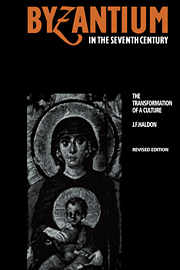Book contents
- Frontmatter
- Contents
- List of plates
- List of maps
- Preface and acknowledgements
- Preface to the revised edition
- List of abbreviations
- The sources
- Introduction
- 1 The background: state and society before Heraclius
- 2 The East Roman world c. 610–717: the politics of survival
- 3 Social relations and the economy: the cities and the land
- 4 Social relations and the economy: rural society
- 5 The state and its apparatus: fiscal administration
- 6 The state and its apparatus: military administration
- 7 Society, state and law
- 8 The imperial church and the politics of authority
- 9 Religion and belief
- 10 Forms of social and cultural organisation: infrastructures and hierarchies
- 11 Forms of representation: language, literature and the icon
- Conclusion: The transformation of a culture
- Addendum: Further observations on the question of the late ancient city
- Bibliography
- Index
4 - Social relations and the economy: rural society
Published online by Cambridge University Press: 13 November 2009
- Frontmatter
- Contents
- List of plates
- List of maps
- Preface and acknowledgements
- Preface to the revised edition
- List of abbreviations
- The sources
- Introduction
- 1 The background: state and society before Heraclius
- 2 The East Roman world c. 610–717: the politics of survival
- 3 Social relations and the economy: the cities and the land
- 4 Social relations and the economy: rural society
- 5 The state and its apparatus: fiscal administration
- 6 The state and its apparatus: military administration
- 7 Society, state and law
- 8 The imperial church and the politics of authority
- 9 Religion and belief
- 10 Forms of social and cultural organisation: infrastructures and hierarchies
- 11 Forms of representation: language, literature and the icon
- Conclusion: The transformation of a culture
- Addendum: Further observations on the question of the late ancient city
- Bibliography
- Index
Summary
ESTATES AND LANDLORDS
Land, whether exploited by arable farming – cereals, vegetables, fruit and so forth – or by pastoral farming, constituted the dominant means of production in the Byzantine world, as indeed it does in all pre-industrial cultures. The relationship between those who work the land and produce the wealth from it, and those who own or control the land and the uses to which it is put, is crucial for an understanding of how late Roman and early Byzantine society worked. Even more so than in other areas, however, the limited number of sources which can be usefully employed in clarifying this aspect of early Byzantine history is a major hindrance. Apart from the legal texts of the later sixth century, particularly imperial novellae and apart from the late seventh- or early eighth-century Farmers' Law (which is still very much debated with regard to its date, its origins and the extent to which its precepts can be generalised for the whole empire), we have to rely upon casual references in literary texts, the results of archaeological work on the economy of the urban settlements – referred to in the previous section – and upon inferences based on the situation as it is known in the earlier and later periods, and the possible logic of the changes which are implied. In this section, I will begin by looking at the situation in the later sixth century.
As we have seen, the state (in the form of the res privata, the domus divinae and the fundi pathmoniales) along with the Church and the senatorial elite formed the most powerful grouping of landowners or landholders in the empire.
- Type
- Chapter
- Information
- Byzantium in the Seventh CenturyThe Transformation of a Culture, pp. 125 - 172Publisher: Cambridge University PressPrint publication year: 1990



